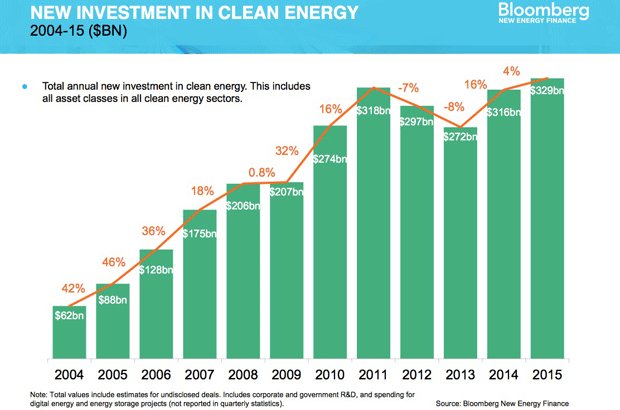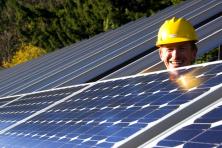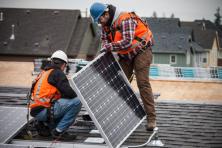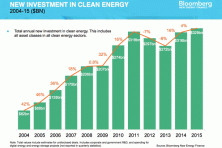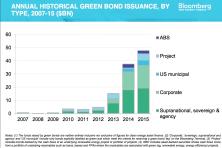New investment in clean energy projects globally reached a record $329 billion in 2015, a clear indication of the momentum towards a low carbon future. This represents an almost 60% increase over 2009 and is roughly four times greater than it was 10 years ago. The record investment numbers are particularly noteworthy against the backdrop of plummeting fossil fuel prices. Over the past two years, natural gas and coal prices have fallen 58%[1] and 56%[2], respectively.
According to Bloomberg New Energy Finance, investment was strong from both the developed and developing regions of the world. Investments from China led the pack with $110. 5 billion. The US was second at $56 billion, an increase of 8% over 2014. The largest investments were utility-scale wind and solar projects. Rooftop solar investment also grew by 12% and totaled $67.4 billion for the year with Japan, the US, and China as the top three contributors.
The global capital markets continue to evolve as investors evaluate their portfolios with a low carbon future in mind and look for investments that will have an environmental impact. Large institutional investors are increasingly focused on the risk and potential opportunities of the transition to a low carbon economy. The New York Common Retirement Fund (“Fund”), the third largest pension fund in the US, has long supported climate aware strategies. In December, the Fund announced an innovative approach to low carbon investment with the creation of a $2 billion low carbon equity index fund.
The low emissions index will be modeled after the Fund’s existing indices, which are passive investments in US companies with returns that match broad market performance. The new index will be weighted toward companies that have lower emissions with comparable earnings. According to the Fund, the low emission index will eliminate or underweight stock ownership in some of the worst greenhouse gas emitters based on emissions data reported to the Carbon Disclosure Project CDP, an independent organization that measures companies’ greenhouse gas emissions. The emissions profile of the new index is expected to be reduced by 70 percent compared to the Russell 1000.
The intention of the Fund in creating the new index is to match returns as closely as possible to the Russell 1000 while greatly reducing its emissions profile and risk. This type of innovation from a large, sophisticated institutional investor is an indication of the changing sentiment in financial markets toward the risks from climate change. As the Fund’s Chief Investment Officer Vicki Fuller states: “As a long-term investor we are very interested in strategies that manage risk, and there is no question that climate change is one of the biggest risks facing global investors across multiple sectors. By shifting our capital to companies with lower emissions and comparable returns, we are sending the message that our investment dollars will follow businesses with strong environmental practices.”
[1] According to the EIA, in January 2013, the natural gas spot price was 3.33 dollars per million Btu (British thermal units), and in December 2015, was 1.93 dollars per million Btu. https://www.eia.gov/dnav/ng/hist/rngwhhdm.htm
[2] The price of Australian Coal in January 2013 was 92.77 $/mt, and in December 2015 was 52.13 $/mt, a 56.2% drop. http://pubdocs.worldbank.org/pubdocs/publicdoc/2016/2/891891454514292219/CMO-Pink-Sheet-February-2016.pdf
